eupedia.com/forum/showthread.php?t=25506 Maciamo: I2a appeared in southern Europe during the Ice Age. It is associated with native Europeans before the spread of agriculture. Because it is very widespread, in ancient times it could be Greek, Dalmatian, Dacian, Illyrian, Roman or even Celtic. I2a1 is the Western version (Italy, France, Iberia), while I2a2 is Eastern (Balkans, Greece, Poland, Russia). But many people are just I2a. I2a2 = Dinaric, ex-Yugoslavia, or what was called Illyria in Greco-Roman times. The highest percentage of I2a (probably I2a2) is found in Dalmatia and Herzegovina. Dalmatia is part of Croatia, and Herzegovina is part of Bosnia (actually, the name of country is Bosnia and Herzegovina). Both regions are mostly populated by the same ethnic group – Croats. The border between Dalmatia and Herzegovina is just a political one, there is no natural border and you’ll find the same people at both sides.
www.jogg.info/41/Wiik.pdf ; office.live.com/OldEurope/Origin of Europeans 2008.pdf
The migration routes of the ancestors of European men from Africa to Europe. Grey routes show the genetic developments (by mutations) of European Haplogroups E3b, F, G, I, j, N, and R1. Coloured circles = the approximate geographic locations of the main four male populations during the last glacial maximum (LGM) about 20 kya. Red, blue, brown, and yellow arrows show essential population movements during the recolonization of northern europe during the late glacial period (about 16-10 kya). Green arrows indicate arrival of Early Farmers in the Balkans and Mediterranean coast about 10 kya.
About 10 kya the farmers of the Middle East, representing African Clan E (its sub-clan E3b) and two sub-clans of F (the “Caucasian” Clan G and the “Near Eastern” Clan J), spread to Anatolia and further to Greece and the Mediterranean coast. Clans I, E3b, J, and  G all originate from the Middle East, but only E3b, J, and G (not I) belong to the group of “Early Farmers.” Clan I had spread into Europe before the emergence of effective domestication of wild plants and animals (i.e. the beginning of agriculture and cattle raising) in the Middle East. Because of their early departure, they were still hunter-gatherers at the time of the arrival of the Early Farmers in the Balkans, and they were taught to cultivate land and raise cattle by their ”Middle East brothers” after the ”reunion of the family” in the Balkans. Accordingly, Clan I represents the “Old Europeans,” rather the Early Farmers.
G all originate from the Middle East, but only E3b, J, and G (not I) belong to the group of “Early Farmers.” Clan I had spread into Europe before the emergence of effective domestication of wild plants and animals (i.e. the beginning of agriculture and cattle raising) in the Middle East. Because of their early departure, they were still hunter-gatherers at the time of the arrival of the Early Farmers in the Balkans, and they were taught to cultivate land and raise cattle by their ”Middle East brothers” after the ”reunion of the family” in the Balkans. Accordingly, Clan I represents the “Old Europeans,” rather the Early Farmers.
European men (more precisely, their Y chromosomes) can be classified into two categories:
(a) Those who are Old Europeans in the sense that, at the start of the LGM, their paternal lineages already were in Europe and they came to the four refuges when they were forced out of northern Europe. They were first to repopulate Europe after the LGM and they formed the bulk of the present European male population.
(b) Those who during the Ice Age still were in the warm regions of Asia and Africa. These latter populations came to Europe during the Neolithization of Europe (the arrival of farming) that started about 10 kya. The frequencies of the two groups of men are shown in the tables in columns OE (Old Europeans) and EF (Early Farmers). The frequency of the Old Europeans will be considered here as the sum of R1b + R1a + I + N and that of the Early Farmers is the sum of E3b + J2 + G.
Four refuges and their typical Y-chromosome haplogroups. From west to east they are the
Iberian, Balkan, Ukrainian, and Siberian refuges. The bigger circles represent the four refuges, and
the smaller ones the peak areas of the corresponding populations today.
I call the two groups of haplogroups and clans “Early Farmers” and “Old Europeans.”
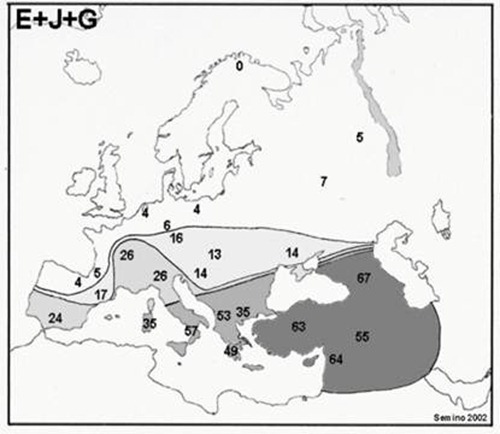 In the Middle East and Anatolia, the Early Farmers represent the majority (about 55-64%), while in Europe the frequency declines sharply in a clinal gradient from about 35-57% of the male populations in the southern Balkans and southern Italy, to a frequency near zero in far northwest Europe.
In the Middle East and Anatolia, the Early Farmers represent the majority (about 55-64%), while in Europe the frequency declines sharply in a clinal gradient from about 35-57% of the male populations in the southern Balkans and southern Italy, to a frequency near zero in far northwest Europe.
![clip_image002[7] clip_image002[7]](https://aleximreh.wordpress.com/wp-content/uploads/2011/02/clip_image0027_thumb.jpg?w=526&h=465) The white section of each circle belongs mainly to the Old European populations R1b, I, R1a,
The white section of each circle belongs mainly to the Old European populations R1b, I, R1a,
and N3, while the sum of the coloured sections show the approximate share of the Early Farmers. The map is based on King and Underhill (2002).
The coloured slices of the easternmost three circles in show that the Caucasus was a major source area for G2, Lebanon and Syria were important sources for Clans E3b, J2 came in about equal portions from the Caucasus and Lebanon, with slightly less from Syria. Bellow J2a distr. from anthrocivitas.net/forum
Haplogroup E3b is a branch of the ”African” Haplogroup E. Haplogroup E originated in Africa. This is true also of its European subhaplogroup E3b. In Africa, this subgroup has four separate peak areas; these are in Southern Africa, Morocco, Northern Libya, and the Horn of Africa. The last two bear witness to the route from northwest Africa through Anatolia to Europe. (The frequencies are relatively high also in Anatolia.) Left map – the geographical distribution of Haplogroup E (including all of its subhaplogroups). In Europe, Haplogroup E3b has peak values (about 25%) in Albania; about equally high frequencies are also typical of some other parts of the Balkans and southern Italy. Many of the newcomers representing subclan E3b learnt agriculture on their way through the southwestern part of the Middle East. They represent one group of the typical Early Farmers of Europe.
![clip_image002[20] clip_image002[20]](https://aleximreh.wordpress.com/wp-content/uploads/2011/02/clip_image00220_thumb.jpg?w=365&h=217) Haplogroup R1b has its peak values in West Europe and its total area extends far beyond the eastern border of Europe. The fact that this haplogroup has two secondary peaks outside Europe (one in Georgia and the other in Uiguria) tends to indicate that the R1b men may have arrived in Europe from the Caucasus or Central Asia.
Haplogroup R1b has its peak values in West Europe and its total area extends far beyond the eastern border of Europe. The fact that this haplogroup has two secondary peaks outside Europe (one in Georgia and the other in Uiguria) tends to indicate that the R1b men may have arrived in Europe from the Caucasus or Central Asia.
Kivisild 2005 – R1b: The East-European subgroup stayed in the Ukrainian refuge during the cold periods of the Ice Age. The haplogroup has four peak areas: one in northern India, another in Altai, a third one in the Mari area (Central Volga region), and a fourth one in the Polish-Russian region.
The high frequencies of Haplogroup N in northeastern Europe and practically all Siberia show that the men of this clan came to Europe from the Siberian refuge. This group can also be called “Uralic-Altaic” as many of its present-day representatives speak Uralic (Finno-Ugric) or Altaic languages. Clan N3 extended to the west and east; today, Clan N2 speaks Samoyedic languages, while the western clans of N3 speak Finno-Ugric languages and eastern clans Altaic and Paleo-Siberian languages. ![clip_image002[18] clip_image002[18]](https://aleximreh.wordpress.com/wp-content/uploads/2011/02/clip_image00218_thumb.jpg?w=415&h=239)
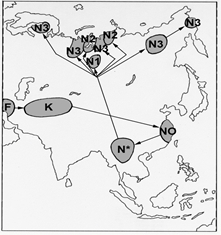
Four language phyla in Europe. Blue = Indo-European, yellow = Finno-Ugrian (Uralic), grey = Turkic (Altaic), and red = Basque. The question of which language a population  speaks today may be more dependent on the languages spoken in the past by ancient men than by those spoken by ancient women. This statement is supported by the idea that women were more mobile than men—the men have supposedly more often stayed in their original living areas, while women have often moved to the homes of their mates. Accordingly, the languages of men have usually remained unchanged while women have sometimes accepted a new language in their new living area. If this is true, Y-chromosome data being reviewed here may provide more information about the spread of ancient languages than mitochondrial DNA.
speaks today may be more dependent on the languages spoken in the past by ancient men than by those spoken by ancient women. This statement is supported by the idea that women were more mobile than men—the men have supposedly more often stayed in their original living areas, while women have often moved to the homes of their mates. Accordingly, the languages of men have usually remained unchanged while women have sometimes accepted a new language in their new living area. If this is true, Y-chromosome data being reviewed here may provide more information about the spread of ancient languages than mitochondrial DNA.
The approximate areas of European language groups: 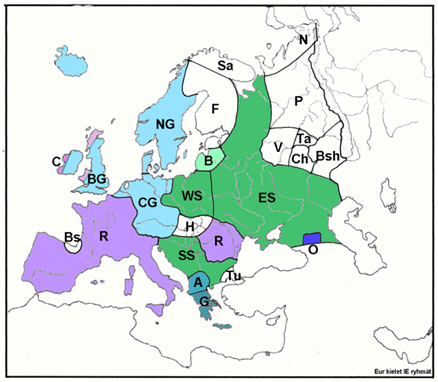 (1) The Indo-European languages: Blue = Germanic (CG = Continental Geramnic, BG = Britain Germanic, and NG = North Germanic), B = Baltic, dark green = Slavic (WS = West Slavic, ES = East Slavic, and SS = South Slavic), C = Celtic, R = Romance, A = Albanian, G = Greek, O = Ossetian.
(1) The Indo-European languages: Blue = Germanic (CG = Continental Geramnic, BG = Britain Germanic, and NG = North Germanic), B = Baltic, dark green = Slavic (WS = West Slavic, ES = East Slavic, and SS = South Slavic), C = Celtic, R = Romance, A = Albanian, G = Greek, O = Ossetian.
(2) The Finno-Ugric (Uralic) languages: F = Finnic, Sa = Saami, V = Volgaic, P = Permic, H = Hungarian (a Ugric language), N = Nenets
(3) The Turkic languages: Ta = Tatar, Ch = Chuvash, Bsh = Bashkirian, Tu = Turkish. (4) The Basque language: Bs
Language Shifts: Contrary to the general way of thinking among traditional linguists, it is apparent that language shifts have been common during the time of modern man in Europe, and by comparing the genome and languages one can make detailed assumptions about the language shifts having taken place in Europe. At least the following eleven major language shifts seem to have occurred in Europe:
The men of the South-Slavic populations of the Balkans are genetically from the Balkan refuge with high frequencies of Haplogroup I1b1-P37, but linguistically they are from the Slavic group. In this case, the Balkan populations (whatever their original language) seem to have shifted their original language to a Slavic one. A strong indication of languages shifts is offered by the existence of the ”Balkan Sprachbund” consisting of a number of languages with unrelated vocabularies, but with similar grammatical and phonological features.
The emergence of the Romance languages is based on the language shift of the original local languages to Latin. Depending on the original local language, the resulting language was, for example, French, Spanish, Portugese, Italian, or Romanian.
In Central and Northern Russia, the original Finno-Ugric languages were replaced by Russian. The original FU-speaking people learnt to speak Russian as their native language.
An equivalent language shift took place in the Baltic area. The Latvian and Lithuanian men are genetically partly from the Siberian refuge with a high N3 frequency and partly from the Ukrainian refuge with high R1a. As the languages of this area are today Baltic, a language shift or, more precisely, a linguistic assimilation, must have taken place. The men who came originally from the Siberian refuge must have shifted their Finno-Ugric language to a Baltic one: The Baltic area consisted earlier of two genetic types (N3 and R1a) and two linguistic types (Finno-Ugric and Indo-European/Baltic); later the two linguistic types were assimilated but the two Y types, of course, remained separate.
A similar language shift may have taken place in northern Central Europe in the area of Proto-Germanic. At least part of this area was earlier inhabited by men representing Haplogroup N3, and the language may have been Finno-Ugric. The present Germanic languages (such as Slavic and Baltic) have a strong Finno-Ugric substratum (Wiik 2002).
Before the arrival of the Angles and Saxons, the language of most of those living in the British Isles was Celtic. Today, Celtic languages are spoken only in the most remote areas of Ireland, Wales, and Scotland. A wave of language shift Celtic > English has swept over the British Isles during the last approximately sixteen hundred years.
A similar language shift that wiped off the Celtic language from Central Europe was more effective than the one in the British Isles. According to the language shift in question, a majority of the Central European Celts learned to speak a Germanic language and a minority learned to speak a West-Slavic (Polish, Czech, and Slovak) language.
Modern Hungarian men are genetically similar to other Central Europeans with high R1b, R1a, and I1b frequencies, but their language is Finno-Ugric. The genetic-linguistic discrepancy can be solved by assuming language shifts in which the local Pannonian men accepted the Hungarian language of the newcomers as their native language. The newcomers were the horseriding tribes that came from the southern Ural Mountains to Pannonia in 500-895 AD. Hungarian men came from three different refuges: Iberia, resulting in high R1b frequencies, the Balkans, resulting in significant I1b1-P37 frequencies, and the Ukraine, resulting in high R1a frequencies. Linguistically, all speak the same Hungarian language and cannot be distinguished on this basis.
The Slovenes belong to the Central European group with the Hungarians, their immediate geographic neighbours. This is seen in the high R1b value, which is 25.5% for the Slovenes and 20% for the Hungarians; in the other Balkan populations, the R1b values are considerably lower (11-17.6%). This is an example of geographic nearness being a more relevant factor than linguistic relatedness. The Slovenes and Croats are genetically distant from each other, even if they speak related (South-Slavic) languages, while the Slovenes and Hungarians are genetically close to each other, even if they speak unrelated languages. This complicated genetic-linguistic relation may be explained by the fact that there was previously a mostly homogeneous population that spoke a common language, but then part of the population shifted language and the original language was replaced by Hungarian in some areas and by SouthSlavic in others.
The Slovenes, Croats, and Macedonians (all of whom are Slavic-speaking) originate more strongly thanothers from the Ukrainian refuge. This is seen in their relatively high R1a values: 29.5% in the Slovenes, 31.8% in the Croats, and 35% in the Macedonians. In the other Balkan populations the equivalent frequencies are considerably lower (5.8-16%).
High I-values (mostly I1b1-P37) are typical of the Croats (42%), Bosnians (48%), and Bulgars (42%). In the other Balkan populations, this value is lower (14.2-30.4%). This can be interpreted as a possible indication of the fact that the Croats, Bosnians, and Bulgarians originate from the Balkan refuge more often than their neighbours.
In the Atlantic Europe area, the ”Balkan” Haplogroup I is highest (about 27%) in Holland and slightly lower (14-25%) in Belgium and France; the I-frequency is lowest (below 10%) among the Basques of France. There is a north-south gradient from Holland through Belgium and France to the Basque area. <<Highest I for the Dutsch=Daci.>>
The overall frequencies of the subgroups of Haplogroup I in the entire Iberian area are as follows: I (x I-M26) (6.0%) and I-M26 (3.7%). In Castile, the frequency of both  components of I are quite high, but the ”Sardinian” Haplogroup I-M26 is exceptionally high (19%). The average of the frequencies of Haplogroup I in Iberia is about 10%. The geographic distribution of this haplogroup is peculiar in that the peak area (frequency about 33%) is in the middle of the peninsula (Castile) and the frequencies diminish as the distance from this area increases. In the next zone, frequencies vary from about 12% to about 15%; in the zone still further away from Castile, the frequencies are 6-9%, and in the zone furtherest away from Castile (in the northwestern and southeastern corners of the peninsula) the frequencies are very low (0-3 %).
components of I are quite high, but the ”Sardinian” Haplogroup I-M26 is exceptionally high (19%). The average of the frequencies of Haplogroup I in Iberia is about 10%. The geographic distribution of this haplogroup is peculiar in that the peak area (frequency about 33%) is in the middle of the peninsula (Castile) and the frequencies diminish as the distance from this area increases. In the next zone, frequencies vary from about 12% to about 15%; in the zone still further away from Castile, the frequencies are 6-9%, and in the zone furtherest away from Castile (in the northwestern and southeastern corners of the peninsula) the frequencies are very low (0-3 %).
Strong indications of Early Farmers are seen in the high E3b+J2+G values of the Turks (53.2%), Albanians (51.1%), and Greeks (48.3%). These areas are nonSlavic-speaking coastal areas that were perhaps the first to receive farming in Europe. The lower E3b + J2 + G values of the Macedonians (35%), Bulgarians (29%), Bosnians (28%), Serbs (32%), Slovenes (17.0%), and Croats (11.1%) may indicate that the ancient areas of these populations were not equally suitable for early farming. <<Another explanation for this: the farmers met strong I populations which they could not displace.>>

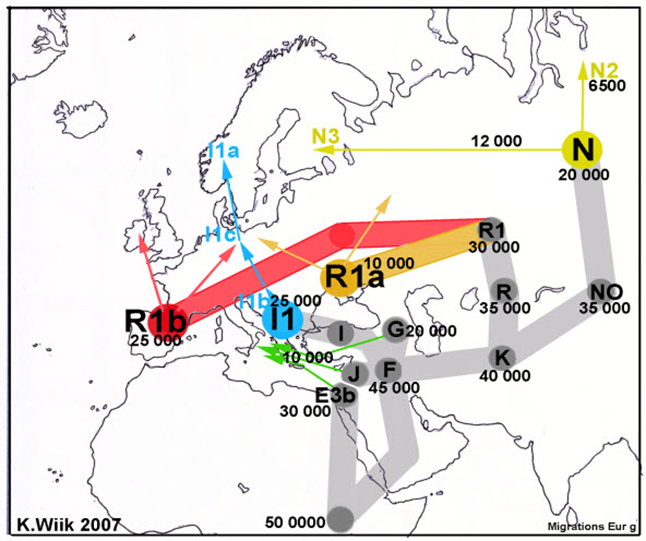

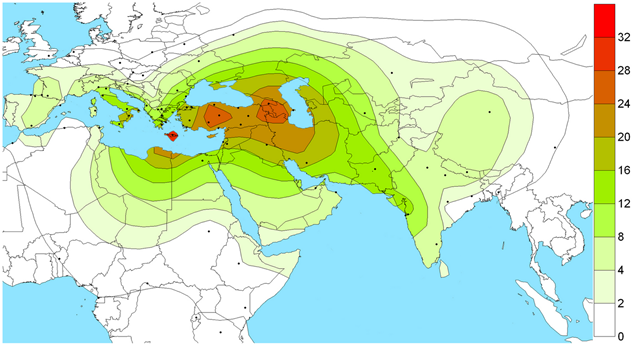

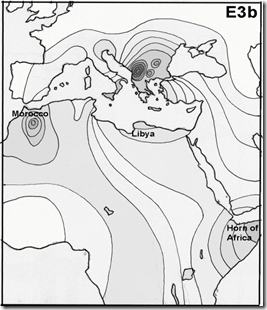
![clip_image002[12] clip_image002[12]](https://aleximreh.wordpress.com/wp-content/uploads/2011/02/clip_image00212_thumb.jpg?w=626&h=274)
![clip_image002[14] clip_image002[14]](https://aleximreh.wordpress.com/wp-content/uploads/2011/02/clip_image00214_thumb.jpg?w=320&h=277)
![clip_image002[16] clip_image002[16]](https://aleximreh.wordpress.com/wp-content/uploads/2011/02/clip_image00216_thumb.jpg?w=314&h=276)
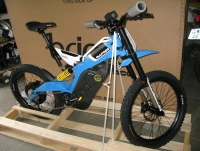

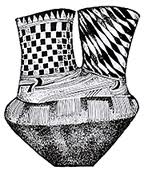


I want to know from where in Slovenia samples were taken. Slovenia has much more R1a than it is found in this study. I collected 320 slovenian samples from all parts (east, west, north, south) of Slovenia and from villages and cities and I got more than 38% R1a, less R1b (around 16%, but I belive it is around 20), 21% I2a2 and 11% I1 and 6% E and 2-3% J and the same G2, etc. It is here: http://www.korenine.si/zborniki/zbornik10/vakar_slo_dnk_bazen.pdf
Magyarul is szeretnem ezt a dolgozatot. Elore is koszonom.
Áldásokban, erőben, egészségben, kitartásban, sok sok örömben és felfedezésben gazdag Újévet kívánok Önnek!